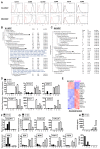Mesenchymal stem cells from human umbilical cord express preferentially secreted factors related to neuroprotection, neurogenesis, and angiogenesis
- PMID: 23991127
- PMCID: PMC3749979
- DOI: 10.1371/journal.pone.0072604
Mesenchymal stem cells from human umbilical cord express preferentially secreted factors related to neuroprotection, neurogenesis, and angiogenesis
Abstract
Mesenchymal stem cells (MSCs) are promising tools for the treatment of diseases such as infarcted myocardia and strokes because of their ability to promote endogenous angiogenesis and neurogenesis via a variety of secreted factors. MSCs found in the Wharton's jelly of the human umbilical cord are easily obtained and are capable of transplantation without rejection. We isolated MSCs from Wharton's jelly and bone marrow (WJ-MSCs and BM-MSCs, respectively) and compared their secretomes. It was found that WJ-MSCs expressed more genes, especially secreted factors, involved in angiogenesis and neurogenesis. Functional validation showed that WJ-MSCs induced better neural differentiation and neural cell migration via a paracrine mechanism. Moreover, WJ-MSCs afforded better neuroprotection efficacy because they preferentially enhanced neuronal growth and reduced cell apoptotic death of primary cortical cells in an oxygen-glucose deprivation (OGD) culture model that mimics the acute ischemic stroke situation in humans. In terms of angiogenesis, WJ-MSCs induced better microvasculature formation and cell migration on co-cultured endothelial cells. Our results suggest that WJ-MSC, because of a unique secretome, is a better MSC source to promote in vivo neurorestoration and endothelium repair. This study provides a basis for the development of cell-based therapy and carrying out of follow-up mechanistic studies related to MSC biology.
Conflict of interest statement
Figures




References
-
- Horwitz EM, Prockop DJ, Fitzpatrick LA, Koo WW, Gordon PL et al. (1999) Transplantability and therapeutic effects of bone marrow-derived mesenchymal cells in children with osteogenesis imperfecta. Nat Med 5: 309-313. doi:10.1038/6529. PubMed: 10086387. - DOI - PubMed
-
- Kawada H, Fujita J, Kinjo K, Matsuzaki Y, Tsuma M et al. (2004) Nonhematopoietic mesenchymal stem cells can be mobilized and differentiate into cardiomyocytes after myocardial infarction. Blood 104: 3581-3587. doi:10.1182/blood-2004-04-1488. PubMed: 15297308. - DOI - PubMed
-
- Ripa RS, Haack-Sørensen M, Wang Y, Jørgensen E, Mortensen S et al. (2007) Bone marrow derived mesenchymal cell mobilization by granulocyte-colony stimulating factor after acute myocardial infarction: results from the Stem Cells in Myocardial Infarction (STEMMI) trial. Circulation 116: I24-I30. PubMed: 17846310. - PubMed
-
- Bang OY, Lee JS, Lee PH, Lee G (2005) Autologous mesenchymal stem cell transplantation in stroke patients. Ann Neurol 57: 874-882. doi:10.1002/ana.20501. PubMed: 15929052. - PubMed
-
- Chen J, Li Y, Wang L, Zhang Z, Lu D et al. (2001) Therapeutic benefit of intravenous administration of bone marrow stromal cells after cerebral ischemia in rats. Stroke 32: 1005-1011. doi:10.1161/01.STR.32.4.1005. PubMed: 11283404. - DOI - PubMed
Publication types
MeSH terms
Substances
LinkOut - more resources
Full Text Sources
Other Literature Sources
Molecular Biology Databases

